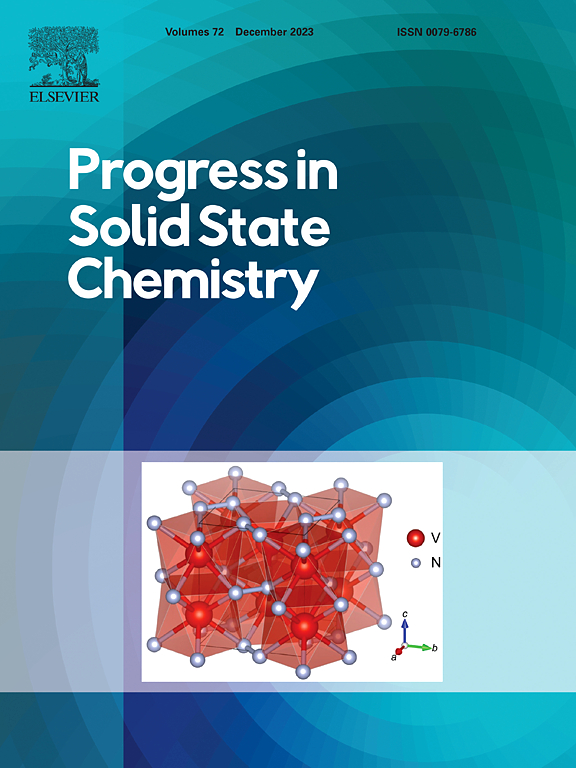Insights into the structure and polymerization mechanisms of CO molecules under pressure
IF 10.5
2区 化学
Q1 CHEMISTRY, INORGANIC & NUCLEAR
引用次数: 0
Abstract
High pressure technique can greatly enrich the chemistry research by innovating the traditional research paradigm. Recently, tremendous attentions have been paid to the high-pressure behavior of low-Z molecules, such as CO, CO2, N2, O2 and mixtures. These molecules tend to polymerize into extended solids at the pressure of 1–100 GPa, but the structures and polymerization mechanisms are still poorly understood. Herein, as a research model, high pressure polymerization process of carbon monoxide (CO) is studied in detail both experimentally and theoretically. The in-situ Raman spectra and angle-resolved X-ray diffraction experiments prove the successful synthesis of p-CO and its amorphous structure. The theoretical simulations reveal that two CO molecules dimerize into the ethylenedione (OCCO) diradical with spin-polarized singlet state firstly, then the OCCO diradical induces the subsequent chain elongation, ring closure and chain crosslinking reactions, leading to formation of the amorphous 3D network. The multiple basic units, hybrid coordination of C/O atoms and complex connecting styles in p-CO are revealed. Based on the polymerization mechanisms, the fundamental principles governing the character (amorphous or crystalline) of extended solids under high pressure are elucidated. Due to the small dipole moment and the head-to-tail disorder of CO molecules, it is reasonable to speculate that crystalline p-CO may exist under more rigorous conditions than 110 GPa and 2000 K, at which the isoelectronic nitrogen (N2) molecules polymerize into a single-bonded cubic form of nitrogen. Our study provides a profound insight into the polymerization mechanism and structures of low-Z CO molecules under compression, contributes to the diversified chemical researches and has a generally scientific implications for the interior dynamics of planets.
深入了解 CO 分子在压力下的结构和聚合机制
高压技术创新了传统的研究范式,极大地丰富了化学研究。近年来,人们对 CO、CO2、N2、O2 和混合物等低 Z 值分子的高压行为给予了极大关注。这些分子往往会在 1-100 GPa 的压力下聚合成扩展固体,但人们对其结构和聚合机制仍知之甚少。本文以一氧化碳(CO)的高压聚合过程为研究模型,从实验和理论两方面进行了详细研究。原位拉曼光谱和角分辨 X 射线衍射实验证明了 p-CO 的成功合成及其无定形结构。理论模拟揭示了两个 CO 分子首先二聚为具有自旋极化单重态的乙烯二酮(OCCO)二元对偶体,然后 OCCO 二元对偶体诱导了后续的链伸长、闭环和链交联反应,从而形成了非晶态三维网络。揭示了 p-CO 中的多个基本单元、C/O 原子的混合配位和复杂的连接方式。根据聚合机理,阐明了高压下扩展固体特性(无定形或结晶)的基本原理。由于一氧化碳分子的偶极矩小且头尾无序,我们有理由推测结晶对一氧化碳可能存在于比 110 GPa 和 2000 K 更严格的条件下,在此条件下,等电子氮(N2)分子聚合成单键立方氮形式。我们的研究深刻揭示了低Z CO分子在压缩条件下的聚合机理和结构,有助于开展多元化的化学研究,并对行星内部动力学具有普遍的科学意义。
本文章由计算机程序翻译,如有差异,请以英文原文为准。
求助全文
约1分钟内获得全文
求助全文
来源期刊

Progress in Solid State Chemistry
化学-无机化学与核化学
CiteScore
14.10
自引率
3.30%
发文量
12
期刊介绍:
Progress in Solid State Chemistry offers critical reviews and specialized articles written by leading experts in the field, providing a comprehensive view of solid-state chemistry. It addresses the challenge of dispersed literature by offering up-to-date assessments of research progress and recent developments. Emphasis is placed on the relationship between physical properties and structural chemistry, particularly imperfections like vacancies and dislocations. The reviews published in Progress in Solid State Chemistry emphasize critical evaluation of the field, along with indications of current problems and future directions. Papers are not intended to be bibliographic in nature but rather to inform a broad range of readers in an inherently multidisciplinary field by providing expert treatises oriented both towards specialists in different areas of the solid state and towards nonspecialists. The authorship is international, and the subject matter will be of interest to chemists, materials scientists, physicists, metallurgists, crystallographers, ceramists, and engineers interested in the solid state.
 求助内容:
求助内容: 应助结果提醒方式:
应助结果提醒方式:


